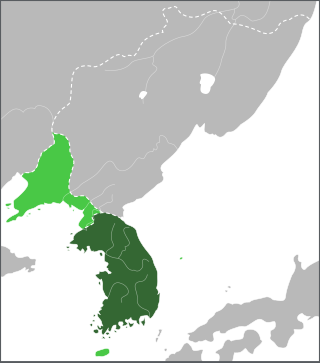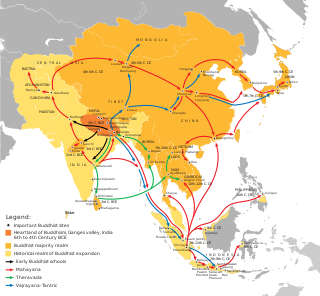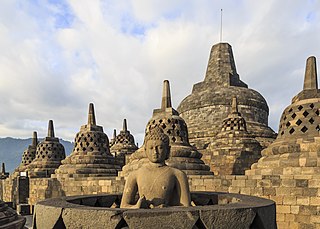The Buddhism Central Museum (former Museum of Korean Buddhist Art) is a Buddhism museum in Wonseo-dong, Jongno District, Seoul, South Korea.

Nalanda was a renowned Buddhist mahavihara in ancient and medieval Magadha, eastern India. Widely considered to be among the greatest centres of learning in the ancient world, and often referred to as "the world's first residential university", it was located near the city of Rajagriha, roughly 90 kilometres (56 mi) southeast of Pataliputra. Operating for almost a thousand years from 427 CE until around 1400 CE, Nalanda played a vital role in promoting the patronage of arts and academics during the 5th and 6th century CE, a period that has since been described as the "Golden Age of India" by scholars.

Korean Buddhism is distinguished from other forms of Buddhism by its attempt to resolve what its early practitioners saw as inconsistencies within the Mahayana Buddhist traditions that they received from foreign countries. To address this, they developed a new holistic approach to Buddhism that became a distinct form, an approach characteristic of virtually all major Korean thinkers. The resulting variation is called Tongbulgyo, a form that sought to harmonize previously arising disputes among scholars.

The traditional culture of Korea is the shared cultural and historical heritage of Korea before the division of Korea in 1945.
Buddhist temples are an important part of the Korean landscape. Most Korean temples have names ending in -sa, which means "monastery" in Sino-Korean. Many temples participate in the Templestay program, where visitors can experience Buddhist culture and even stay at the temple overnight.

Unified Silla, or Late Silla, is the name often applied to the historical period of the Korean kingdom of Silla after its conquest of Goguryeo in 668 AD, which marked the end of the Three Kingdoms period. In the 7th century, a Silla–Tang alliance conquered Baekje in the Baekje–Tang War. Following the Goguryeo–Tang War and Silla–Tang War in the 7th century, Silla annexed the southern part of Goguryeo, unifying the central and southern regions of the Korean peninsula.
Buddhist culture is exemplified through Buddhist art, Buddhist architecture, Buddhist music and Buddhist cuisine. As Buddhism expanded from the Indian subcontinent it adopted artistic and cultural elements of host countries in other parts of Asia.

Niō (仁王) are two wrathful and muscular guardians of the Buddha standing today at the entrance of many Buddhist temples in East Asian Buddhism in the form of frightening wrestler-like statues. They are dharmapala manifestations of the bodhisattva Vajrapāṇi, the oldest and most powerful of the Mahayana Buddhist pantheon. According to scriptures like the Pāli Canon as well as the Ambaṭṭha Sutta, they travelled with Gautama Buddha to protect him. Within the generally pacifist tradition of Buddhism, stories of dharmapalas justified the use of physical force to protect cherished values and beliefs against evil. They are also seen as a manifestation of Mahasthamaprapta, the bodhisattva of power that flanks Amitābha in Pure Land Buddhism and as Vajrasattva in Tibetan Buddhism.

The Greco-Buddhist art or Gandhara art is the artistic manifestation of Greco-Buddhism, a cultural syncretism between Ancient Greek art and Buddhism. It had mainly evolved in the ancient region of Gandhara, located in the northwestern fringe of the Indian subcontinent.

Tongdosa is a head temple of the Jogye Order of Korean Buddhism and in the southern part of Mt. Chiseosan near Yangsan, South Gyeongsang Province, South Korea.
The history of Buddhism can be traced back to the 5th century BCE. Buddhism originated from Ancient India, in and around the ancient Kingdom of Magadha, and is based on the teachings of the renunciate Siddhārtha Gautama. The religion evolved as it spread from the northeastern region of the Indian subcontinent throughout Central, East, and Southeast Asia. At one time or another, it influenced most of Asia.

Mahāyāna Buddhism entered Han China via the Silk Road, beginning in the 1st or 2nd century CE. The first documented translation efforts by Buddhist monks in China were in the 2nd century CE via the Kushan Empire into the Chinese territory bordering the Tarim Basin under Kanishka. These contacts transmitted strands of Sarvastivadan and Tamrashatiya Buddhism throughout the Eastern world.

Korean arts include traditions in calligraphy, music, painting and pottery, often marked by the use of natural forms, surface decoration and bold colors or sounds.

Buddhist religious architecture developed in the Indian subcontinent. Three types of structures are associated with the religious architecture of early Buddhism: monasteries (viharas), places to venerate relics (stupas), and shrines or prayer halls, which later came to be called temples in some places.

Throughout the ages, there have been various popular religious traditions practiced on the Korean peninsula. The oldest indigenous religion of Korea is the Korean folk religion, Korean shamanism, which has been passed down from prehistory to the present. Buddhism was introduced to Korea from China during the Three Kingdoms era in the fourth century, and the religion became an important part of the culture until the Joseon Dynasty when Confucianism was established as the state philosophy. During the Late Joseon Dynasty, in the 19th century, Christianity began to take root in Korea. While both Christianity and Buddhism would play important roles in the resistance to the Japanese occupation of Korea in the first half of the 20th century, only about 4% of Koreans were members of a religious organization in 1940.

Jikjisa is a head temple of the Jogye Order of Seon Buddhism. It is located on the slopes of Hwangaksan in Daehang-myeon, Gimcheon, North Gyeongsang Province, South Korea. It may be one of the oldest temples in South Korea.

Buddhist art is visual art produced in the context of Buddhism. It includes depictions of Gautama Buddha and other Buddhas and bodhisattvas, notable Buddhist figures both historical and mythical, narrative scenes from their lives, mandalas, and physical objects associated with Buddhist practice, such as vajras, bells, stupas and Buddhist temple architecture. Buddhist art originated in the north of the Indian subcontinent, in modern India, Pakistan and Afghanistan, with the earliest survivals dating from a few centuries after the historical life of Siddhartha Gautama from the 6th to 5th century BCE.
Malananta was an Indian Buddhist monk and missionary who brought Buddhism to the southern Korean peninsula in the 4th century. Multiple romanizations of Malananta's name may be found, including Meghananda (मेघानंदा), Malananda, Maranant'a and Maalaananda. He was among the first to bring Buddhist teaching, or Dharma, to Korea. The Samguk yusa and Samguk yusa record him as the one who brought Buddhism to King Chimnyu of Baekje in 384 CE, along with Sundo in Goguryeo and Ado in Silla. Buddhism, a religion originating in what is now India, was transmitted to Korea via China in the late 4th century.

The Northern and Southern States period is the period in ancient Korean history when Unified Silla and Balhae coexisted in the south and north of the peninsula, respectively.
Korean Buddhist sculpture is one of the major areas of Korean art. Buddhism, a religion originating in what is now India, was transmitted to Korea via China in the late 4th century. Buddhism introduced major changes in Korean society. The complexity of the religious sutras sent to Korea required the aristocrats who adopted the religion to become literate and required the training and importation of literate scribes. Little evidence of religious art exists in Korea before the introduction of Buddhism. Subsequent to its introduction, the religion inspired the production of devotional art as well as the beginnings of sophisticated temple architecture.

Buddhism in Pakistan took root some 2,300 years ago under the Mauryan king Ashoka who sent missionaries to the Kashmira-Gandhara region of North West Pakistan extending into Afghanistan, following the Third Buddhist council in Pataliputra.